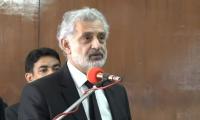Further provisional census figures released by the Pakistan Bureau of Statistics on Monday give a sense of the scale of urbanisation that has taken place over the last two decades. A full 20 percent of the country’s population now lives in just 10 cities, with Quetta, Lahore and Faisalabad showing the largest percentage increase in population. The population of Lahore has increased by 75 percent since the 1999 census, although this figure seems to be slightly inflated due to the provincial government’s reclassification of the city’s borders. Despite these startling numbers, the overall urban population of Pakistan is still calculated at only 36 percent. This is mainly due to the faulty definitions of ‘urban’ and ‘rural’ by provincial governments. The urban sprawl that has pushed cities beyond their previous limits ends up being counted as rural even though these areas would be recognised as urban by any knowledgeable observer. There is also no standard definition of urban and rural areas. Lahore, for example, is classified as entirely urban while other cities in Punjab have an urban-rural divide. Even in the 1999 census, researchers had estimated that the true urban population would be about 10 percentage points higher than that listed in the census. Since then, the pace of urbanisation has only increased.
The provisional results have caused some consternation in Sindh. The PPP government feels the population of the entire population has been undercounted – although it has not yet given any basis for this allegation. The MQM government has rejected the figures given for Karachi due to the city only having a population of 14.9 million while Lahore is at 11.3 million. A closer look at this criticism is essential though. The issue seems to be that close to five million residents of what we know as Karachi are not included in the city’s population because they have been designated as rural areas – by the very political parties that are now alleging manipulation. According to experts, one of the reasons this was done was so that politicians and other members of the elite who owned property in emerging areas such as Malir would have to pay a lower rate of property tax. Ultimately these classifications, while bringing down the official population of Karachi, should not affect the distribution of parliamentary seats since there is no evidence of data manipulation yet. Perhaps a better approach to the census could be for all these political parties to try and figure out how better to serve this ballooning urban population. Development and provision of services have obviously not kept up with the pace of urbanisation. The census now gives us stark numbers of just how much of our population is crammed into urban areas. Taking care of their needs now has to be a priority.
Shahzaib Rind, Pakistan's martial arts fighter from Quetta. — Facebook/shahzaibrindhofficial/FileShahzaib Rind has...
A representational image showing women at a market. — AFP/FileIn the six weeks since he assumed office, not only has...
Country witnessed 432 violence-linked fatalities and 370 injuries among civilians, security personnel, and outlaws
During Raisi’s visit, Iran and Pakistan signed a total of eight accords on varying subjects to enhance cooperation...
Every year, millions of girls silently say goodbye to their education and the promise of a better career and get married
Ruling party emerged victorious in by-elections and as per unofficial results has won at least two out of five NA...







